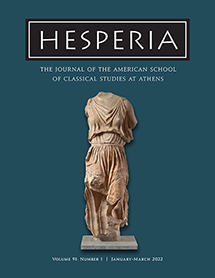Hesperia 91.1 Now Online!

We are pleased to announce the publication of Hesperia 91.1! Topics in this issue include an examination of the development of cooking dishes in the prehistoric Aegean, visual representations of the myth of Philomela and Prokne in Athenian vase painting, the concluding remarks regarding the comprehensive study of the sculptures from the Temple of Ares, and the publication of the Roman curse tablets from the Athenian Agora.
Subscribers can read the issue online at Project MUSE, which now hosts current issues of Hesperia as well as an archive of past volumes dating to 2002. Hesperia remains on JSTOR as part of their Arts and Sciences II package, with the usual three-year moving wall. Additionally, all issues of Hesperia from 2011 and earlier are available as Open Access on our website. The printed version will be mailed shortly.
Ceramic Cooking Dishes in the Prehistoric Aegean: Variability and Uses, by Anastasia Dimoula, Zoï Tsirtsoni, and Soultana Maria Valamoti, discusses the history of cooking dishes—namely, large, open and shallow, undecorated ceramic vessels—following their diachronic development from the Neolithic to the Iron Age (6th millennium to 8th century B.C.), and their synchronic distribution across the Aegean and the Balkans. The methodological approach involves a synthesis of the information available in the archaeological literature, including experimental and ethnographic material. The morphological, technological, and functional attributes of cooking dishes are reviewed, and their contexts of use are reconstructed. The ultimate aim is to deduce the role of these vessels in past culinary activities, to contribute to discussions on their function(s), and to aid ceramicists in further developing protocols for future analyses and experimentation.
Visualizing the Traumatized: Athenian Images of Philomela and Prokne, by Danielle Smotherman Bennett, examines the tale of Philomela and Prokne—a dramatic narrative involving betrayal, murder, and metamorphosis. The article reexamines Athenian vase paintings of the subject dating to ca. 525–420 B.C. through the lens of trauma, including both what constitutes trauma in antiquity and problems in portraying trauma in vase painting. In the images, artists use visual markers of gaze, gesture, body language, and sounds, possibly represented by nonsense inscriptions, to distinguish the two sisters from one another. Using visual markers, Philomela and Prokne are shown not only as unconventional and traumatized but also as strong women who break from female sociocultural boundaries to seek vengeance.
Classical Sculpture from the Athenian Agora, Part 4: Concluding Remarks on the Sculptures of the Temple of Ares (Athena Pallenis), by Andrew Stewart, Erin Lawrence, Rebecca Levitan, and Kelsey Turbeville, represents the final article in a series of four that summarizes the results of a decade of work on the sculptures of the Temple of Ares, and it supersedes some of the tentative conclusions advanced earlier in the series. It assesses the original Periklean project (especially its possible genesis as a response to the plague of 430–426 B.C.) and the Augustan modifications to it after the temple’s transfer from Pallene to the Agora ca. 15 B.C. A chronological appendix charts the temple’s prehistory from the 8th century B.C. through the Persian sack of 480; its history from ca. 430 through its destruction in late antiquity; and finally its recovery from the Greek excavations of 1891 to the present.
Curse Tablets of the Roman Period from the Athenian Agora, by David R. Jordan, presents 30 curse tablets from underground bodies of water in the Athenian Agora. These include 22 tablets from a well by the Civic Offices concerning slaves (a manumission, the prosecution of runaways), unpaid loans, and foreigners. Tablets from other wells include curses against athletes and thieves, a “ritual diabolê” to bring harm to an enemy, and the first known curse tablet in Athens addressed to the Nymphs. Three previously published texts (reread with a stereoscopic microscope) are presented again; the majority are published here for the first time.
Click here to subscribe to Hesperia. In addition to receiving printed issues and online access to Hesperia, subscribers also receive complimentary online access to Hesperia Supplements, and Agora and Corinth volumes.
Hesperia welcomes submissions from scholars working on all aspects of Greek material culture, including archaeology, art, architecture, history, epigraphy, and related studies. Further information about the journal, including instructions for preparing manuscripts for submission, can be found on our website.
The Friends of Hesperia was founded in 2014 to help fund the journal's growth in all its manifestations. We invite you to become a member today and help support one of the most preeminent journals in the field of Mediterranean archaeology.